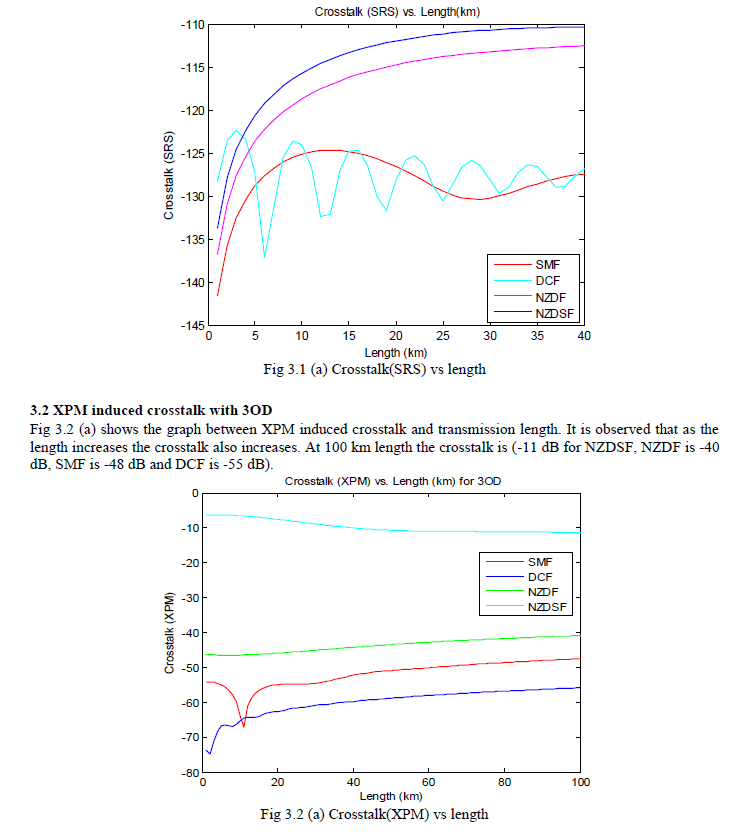ISSN ONLINE(2319-8753)PRINT(2347-6710)
ISSN ONLINE(2319-8753)PRINT(2347-6710)
P. Singh 1 , A. Singhal2
|
| Related article at Pubmed, Scholar Google |
Visit for more related articles at International Journal of Innovative Research in Science, Engineering and Technology
In optical wavelength-division multiplexing (WDM) systems, if the number of users are increased, the crosstalk becomes more severe due to imperfections in the optical passive networks and nonlinear effects in the optical fiber. In this research paper Stimulated Raman Scattering (SRS) and Cross Phase Modulation (XPM) are studied as the source of nonlinear degradation in the multichannel system. The crosstalk induced by SRS and XPM has been evaluated for wavelength division multiplexed networks. In SRS induced crosstalk it is observed that as the modulation frequency increases the crosstalk decreases and for XPM as the modulation frequency increases the crosstalk increases. These variations have been observed for different transmission lengths.
Keywords |
| SRS, XPM, NZDF, NZDSF, transmission length. |
INTRODUCTION |
| The growing bandwidth requirement of high-speed digital communication systems can only be met by incorporating the wideband optical wavelength division multiplexed (WDM) system. However an optical WDM communication system suffers from performance degradation due to fiber attenuation, chromatic dispersion and fiber nonlinear effects including stimulated Raman scattering (SRS), stimulated Brillouin scattering, four wave mixing, self- and cross-phase modulation [1-2]. Among all these effects, stimulated Raman scattering (SRS) and Cross Phase Modulation (XPM) are the major limitations of system performance. The Raman scattering effect is the inelastic scattering [3] of a photon with an optical phonon, which originates from a finite response time of the third order nonlinear polarization [4] of the material. When a monochromatic light beam propagates in an optical fiber, spontaneous Raman scattering occurs. It transfers some of the photons to new frequencies. The scattered photons may lose energy (Stokes shift) or gain energy (anti-Stokes shift). If the pump beam is linearly polarized, the polarization of scattered photon may be the same (parallel scattering) or orthogonal (perpendicular scattering). If photons at other frequencies are already present then the probability of scattering to those frequencies is enhanced. This process is known as stimulated Raman scattering. It induces a unilateral power transfer from shorter to longer wavelength channels through the excitation of molecular vibrations. This effect primarily results in a tilt in the spectral power distribution of the transmission channels and leads to channel-tochannel crosstalk and to a power penalty in the short wavelength channels [5]. The amount of tilt depends mostly on the width of the wavelength band populated with channels and the total launch power into the fiber [6-7]. Increasing or decreasing the number of active channels changes the total launched power. The resulting change of the inter channel SRS tilt causes fluctuations in the power envelope or time averaged power of surviving channels. The mechanism responsible for the generation of power fluctuations is based on channel interactions [7] Stimulated Raman scattering implications have been studied extensively theoretically [4] and experimentally [7-8]. A four- wavelength bi-directional DWDM CATV system used chirped fiber gratings as the dispersion compensation devices to reduce the fiber dispersion and XPM-induced crosstalk simultaneously [9]. SRS and SBS transfer energy from pump pulse to generate stoke pulses which co-propagates along with the pump signal in the same or opposite direction if the peak power of the incident waves is more than the threshold level, and these two pulses interact with each other through the raman gain and XPM[10]. Therefore, by seeing the increasing demand of high bandwidth and modulation frequency for optical fiber communication transmission system , there is a need to consider the effect of higher order dispersion. The expression for SRS and XPM induced crosstalk is presented in section 2 after describing the brief introduction in section 1. Results and discussions are presented in section 3 and finally section 4 concludes the paper. |
II. SRS AND XPM INDUCED CROSSTALK |
 |
III. RESULT ANALYSIS |
| Here , the results have been mentioned for SRS and XPM induced crosstalk using different fibers as SMF, DCF, NZDF and NZDSF with variation in transmission length. 3.1 SRS induced crosstalk Fig 3.1(a) shows the graph between SRS induced crosstalk with transmission length with varied fiber parameters. The transmission length have been varied in a range of 0 to 40 Km and it has been observed that the SRS induced crosstalk increases with the increase in length at constant modulation frequency. |
 |
IV. CONCLUSION |
| In this paper the impact of SRS and 3OD XPM induced crosstalk in an optical fiber communication transmission system for different types of optical fibers and transmission length. It has been shown in the results that the crosstalk due to SRS increases with increase of transmission length. Crosstalk due to XPM in presence of higher order dispersion increases with increase in transmission length. By the above results the optical fiber communication transmission system can be optimized to select the minimum value of crosstalk in a given range of transmission length and type of fiber used. |
References |
|